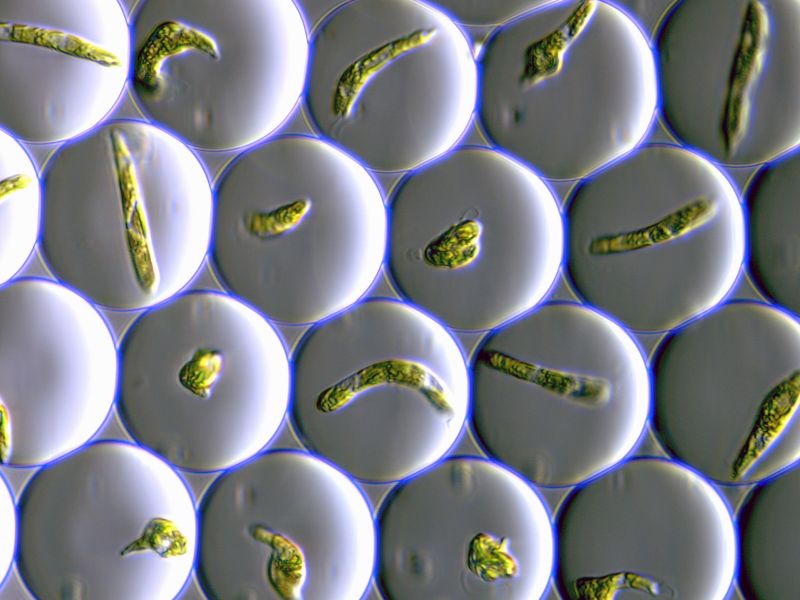Droplet microfluidics has become an established tool in biomedical research for a diverse range of applications, such as chemical assays, biological assays, synthetic biology, digital PCR, drug screening, and clinical diagnostics. It exploits immiscible phases of liquids to produce emulsions of monodisperse droplets that can serve as isolated reaction and transport vessels, which can be manipulated, mixed, analyzed, and sorted by various techniques. Unlike continuous flows in microfluidic devices, isolated drops allow independent monitoring of local conditions in the liquid volume of each droplet. This capability is useful for single-cell analysis because protein secretion, enzyme activity, and proliferation of individual cells or a clonal colony initiated from a single cell can be studied in an isolated environment and potentially selected on the basis of desirable biological and biotechnological properties.
Despite these advantages, conventional high-throughput droplet sorting approaches have been limited to small droplets (<10 pl in volume or <27 μm in diameter), while large droplets (>100 pl in volume or >57 μm in diameter) offer other numerous advantages over small droplets, including higher cellular viability, growth rates, and secretion rates for encapsulated cells, as well as increased reverse transcription efficiency following cell lysis. Furthermore, some larger cells or cell clusters (e.g., algae, tumor spheroids, and embryoid bodies) do not physically fit into smaller droplets. The main challenge that prohibits high-throughput large-droplet sorting is, at the most fundamental level, the increased inertia compared to the surface-free energy of these droplets, resulting in a trade-off relation between sorting throughput and droplet volume. At high sorting rates, larger droplets break into smaller pieces more easily than smaller droplets due to the external force required to redirect the droplet to a separate outlet. To avoid this problem during sorting of large droplets, the sorting rate must be reduced by orders of magnitude to ensure the structural integrity of the droplets and thus the reliability of the results and reproducibility of an experiment. To slow down sorting to such a degree is to forego the advantages of droplet microfluidics over standard microwell plate assays.
Recently, we have developed a sequentially addressable dielectrophoretic array (SADA) chip that overcomes this trade-off, enabling high-throughput sorting of large droplets without any damage to the droplets that reduces sort accuracy and the ability to perform downstream assays. The SADA chip is an on-chip array of electrodes, which are activated and deactivated in a sequence synchronized to the speed and position of a target droplet passing nearby. As the droplet passes each electrode in the array, the electrode delivers a small dielectrophoretic force, the sum of which gently pulls the target droplet in the direction of sorting. In addition to the gentle manipulation, the functionality of sequentially activating and deactivating the electrodes enables the SADA chip to sort out a single target droplet without affecting nontarget droplets in the electrode-array region. The SADA chip enables on-chip fluorescence-activated sorting of large single cells or cell clusters in large droplets (~100 pl) at a record throughput of >4,000 droplets per second. Currently, we work on the development of biological, pharmaceutical, and medical applications based on the SADA technology, which extends high-throughput droplet microfluidics to volumes compatible with cell cultivation, thus opening up single-cell analysis and selection based on new critical cellular processes.
References
- A. Isozaki, Y. Shibata, N. Tanaka, D. L. Setyaningrum, Y. Nakagawa, M. H. Loo, J. Park, Y. Shirasaki, D. Huang, C. Riche, H. Tsoi, T. Ota, H. Miwa, Y. Kanda, T. Ito, K. Yamada, O. Iwata, K. Suzuki, Y. Kato, T. Hasunuma, S. Matsusaka, M. Yamagishi, M. Yazawa, S. Uemura, K. Nagasawa, H. Watarai, D. Di Carlo, and K. Goda, "Sequentially addressable dielectrophoretic array for high-throughput sorting of large-volume biological compartments", Science Advances 6, eaba6712 (2020)
- Y. Nakagawa, S. Ohnuki, N. Kondo, K. Itto, F. Ghanegolmohammadi, A. Isozaki, Y. Ohya, and K. Goda, "Are droplets really suitable for single-cell analysis? A case study on yeast in droplets", Lab on a Chip 21, 3793 (2021)
- M. H. Loo, Y. Nakagawa, A. Isozaki, and K. Goda, "High-throughput sorting of nanoliter droplets enabled by a sequentially addressable dielectrophoretic array", Electrophoresis 43, 477 (2021)
- A. Isozaki, D. Huang, Y. Nakagawa, and K. Goda, "Dual sequentially addressable dielectrophoretic array for high-throughput, scalable, multiplexed droplet sorting", Microfluidics and Nanofluidics 25, 32 (2021)

Large-droplet biomicrofluidics
- Field leader: Tianben Ding
- Funding: JSPS Core-to-Core Program, JST A-STEP
- Collaboration: Serendipity Lab